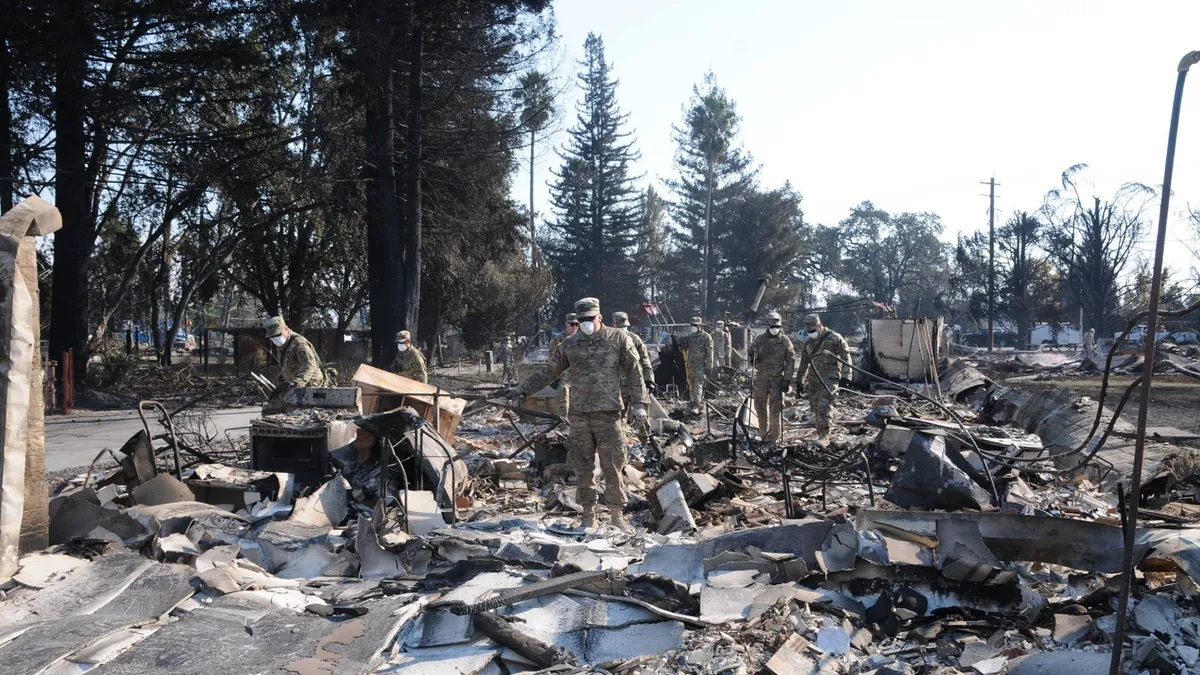UPDATE: Dec. 2, 2019: U.S. Bankruptcy Judge Dennis Montali said the inverse condemnation doctrine applies to Pacific Gas & Electric's bankruptcy case in a Nov. 27 decision, which will be factored into legal proceedings to estimate PG&E's total liabilities that are scheduled to begin in February 2020.
Dive Brief:
-
Pacific Gas & Electric (PG&E) is attempting once more to circumvent the inverse condemnation doctrine, the California policy that holds utilities accountable for all wildfires sparked by their equipment regardless of whether they demonstrate negligence.
-
Inverse condemnation should not apply to investor-owned utilities in California, PG&E attorneys argued at a Nov. 19 hearing before U.S. Bankruptcy Judge Dennis Montali, tasked with supervising the company’s reorganization. PG&E's request, if granted, would reduce its total liabilities since wildfire victims would not receive payouts until a court determines the company was negligent.
-
Utility arguments against inverse condemnation have previously been rejected by the California Public Utilities Commission (CPUC) and other courts. Montali rejected PG&E's argument, saying that the utility is asking him to "set aside a well-seasoned principle of strict liability."
Dive Insight:
This isn’t the first time PG&E has attempted to seek legal recourse against inverse condemnation. Multiple state court decisions have upheld the application of inverse law to PG&E’s wildfire damages.
PG&E’s request appears “bizarre,” according to Michael Wara, senior research scholar at the Stanford Woods Institute for the Environment, and a commissioner on California's Commission on Catastrophic Wildfire Cost and Recovery — not least because one of the basic precepts of bankruptcy law is that laws that exist outside bankruptcy court are not changed inside it.
Reforming inverse condemnation could reduce the value of PG&E’s wildfire settlement claims, but might not be transformative to its financial future, according to Wara. It’s likely that attorneys for the wildfire victims will pivot to alleging negligence or other damages that can go forward with or without the doctrine.
It also raises the question of what the state will replace inverse condemnation with — a decision that requires complicated policy calls that shouldn’t be handled in bankruptcy court. Moreover, taking up inverse condemnation at this stage in PG&E’s reorganization wastes valuable time, Wara said. If the utility doesn’t exit bankruptcy by June 30, 2020, it risks losing access to California’s new wildfire insurance fund, established by AB 1054.
“This is not cooperative; this is hardball and it's more like throwing stuff at the wall to see what sticks,” Wara said.
Inverse condemnation has been a hot topic of discussion in California since 2017, when the CPUC rejected San Diego Gas & Electric’s (SDG&E) request to recover $379 million in costs associated with 2007 wildfires. The doctrine creates “strict liability” for state utilities; so if a power-line sparks a fire, the concerned utility is held accountable for the costs even if it hasn't behaved in a negligent manner. It was meant to be a form of social insurance, PG&E said in an Oct. 25 motion filed with the bankruptcy court, based on the idea that costs could be spread across the taxpayers who benefit from a service provided by a public entity.
“Inverse [condemnation] was developed and actually works in the context of a true public entity” because municipal utilities can either raise their rates or increase taxes to cover large costs, Kevin Orsini said at the hearing.
However, PG&E can’t recover wildfire costs without approval from the CPUC, which applies its own test — called the prudent manager standard — to decide whether utilities can pass costs on to ratepayers. In its 2017 decision, the agency found that SDG&E could not recover costs from the 2007 fire because the utility didn’t “reasonably manage and operate its facilities” beforehand. PG&E, SDG&E and Southern California Edison jointly appealed the CPUC decision, but that request was also denied by the commission in July 2018.
The commission’s rejection of SDG&E’s application differentiates IOUs from publicly-owned utilities, according to PG&E. Essentially, it puts IOUs in a position where they can be held liable for fires under inverse condemnation by state courts, on the assumption that they can recover these costs, but are then prevented from doing so by regulators.
“The whipsaw now facing California’s investor-owned utilities is untenable,” PG&E attorneys said in their Oct. 25 filing.
“It’s a fundamental question of whether or not inverse [condemnation] can apply to a privately-owned utility,” Orsini said.
Lawyers for the victims of the Northern California fires accused PG&E of “forum shopping” for a venue that will rule in its favor on inverse condemnation, since the CPUC and courts have rejected the utility's arguments before. Socializing costs is not a prerequisite for inverse condemnation, David Rivkin, an attorney for the tort claimants committee, told the judge. Rather, the policy prevents individual property owners from bearing the brunt of something that is caused by way of a public service.
Meanwhile, PG&E is preparing to deploy another round of public safety power shut-offs expected to affect 181,000 customer accounts in 16 Northern California counties. Regulators gave the green light to state IOUs in May to proactively de-energize their power-lines when weather conditions increase the chances of a wildfire. PG&E forecasts high fire-risk conditions with strong winds beginning on Wednesday morning and continuing on Thursday, the company said in a press release. Patrols will inspect the de-energized power-lines and the utility hopes to restore power to customers by the end of Thursday.















